Freesia laxa subsp. azurea
Freesia laxa (Thunb.) Goldblatt & J.C.Manning subsp. azurea (Goldblatt & Hutchings) Goldblatt & J.C.Manning
Family: Iridaceae
Common names: small blue freesia, blue flowering grass (Eng.) Natal bloupypie (Afr.)
Introduction
Small blue freesia is a corm with lilac or pale blue flowers with striking purple markings toward the center.
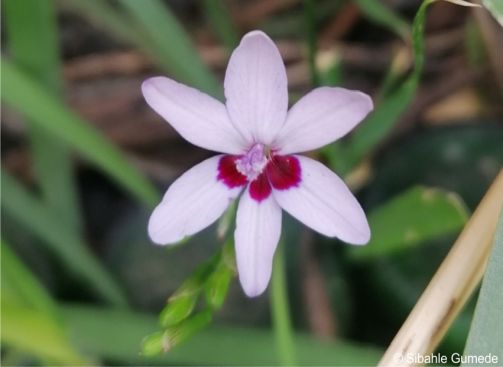
Description
Description
Freesia laxa subsp. azurea is a deciduous cormous geophyte which grows 150-300 mm tall. Stem normally single and erect. The plant comprises of 6-9, suberect, soft-textured, sword-shaped leaves that have a thickened midrib. Flowers pale blue or lilac, sometimes white, with a perianth tube 25-40 mm long and tepals 9-11 mm long and 4 mm wide, the three lower tepals with dark blue to violet markings at the base. Filaments protruding 1-3 mm. Style dividing between the base and middle of the anthers. Flowers are produced in spikes of 2-6 flowers that grow in a horizontal line. Flowering is in winter and early spring (June-September).
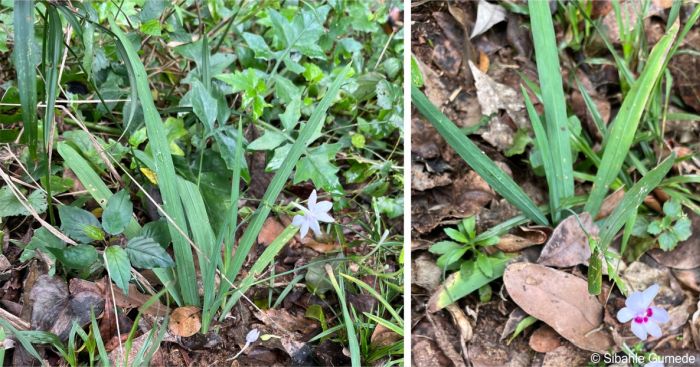
Fruit capsules are oblong-ovoid, 10-12 mm long and 8-10 mm wide. Seeds are subglobose, 3 mm diameter, with inflated raphe (ridge on the side of the seed), smooth and glossy bright red or orange when fresh, darkening to reddish brown when matured.
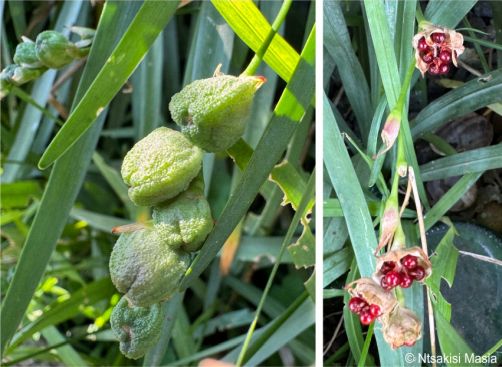
Freesia laxa subsp. azurea is closely related to Freesia laxa subsp. laxa, the two can be easily distinguished by the colour of the flower: the flowers of the subsp. laxa are pink to red with dark red markings on the lower tepals. They also differ in flowering time and habitat, the subsp. laxa flowering in early to midsummer and preferring rocky, montane habitats.
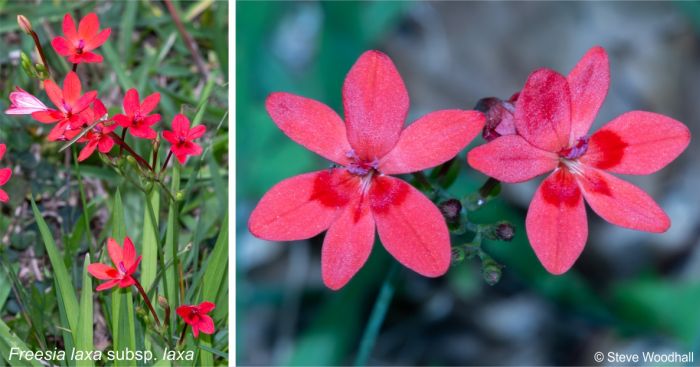
Conservation Status
Status
Freesia laxa subsp. azurea is currently listed on the SANBI Red List as Vulnerable (VU). It is currently known from 10 localities in South Africa, and these localities are facing threats from expanding settlements and development, deforestation and forestry plantations, overgrazing and crop cultivation. An estimate of more than 40% of the population is expected to be lost in the next 10 years due to the above-mentioned threats. Conservation measures have been taken by Millennium Seed Bank Partnership (MSBP) and Kwelera National Botanical Garden by making sure that seeds are banked the right way to ensure the longevity of the seed viability, and by keeping living collections in Kwelera NBG.
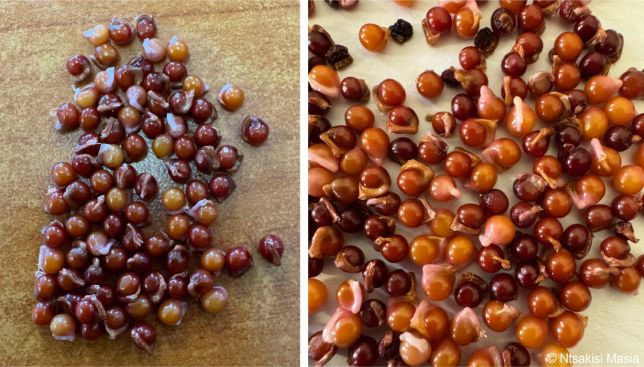
Distribution and habitat
Distribution description
This species is endemic to southern Africa; it is distributed in southern Mozambique and South Africa. In South Africa it is found naturally occurring in KwaZulu-Natal, from Richards Bay all the way to the Mozambique border and beyond. Freesia laxa subsp. azurea grows in coastal habitats in coarse sandy soil, either in open sites like grassy dunes, or in light shaded habitats like forest margins or bush edges, occurring in small colonies.
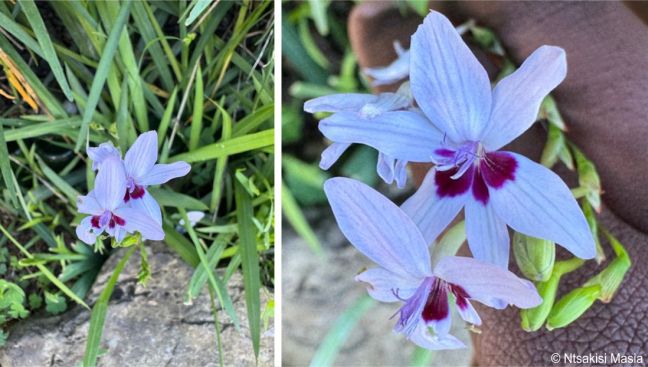
Derivation of name and historical aspects
History
The genus Freesia is found in the Iridaceae, a large family of over 65 genera worldwide and over 1 800 species. The genus Freesia was named after Dr FHT Freese in 1866, he was a German physician from Kiel. Freesia laxa was previously known as Anomatheca, this genus, which had few species, was placed under the genus Freesia which, in South Africa, has about 16 species. The species name laxa means loose or not dense, and this comes from the physical appearance of the plant. The subspecies name azurea comes from a Latin word azureus which means pure deep blue, and it refers to the colour of the flower and its markings.
Ecology
Ecology
Freesia laxa is self-fertile because of the style which branches opposite the anthers at a level where the stigma can contact the pollen. However, pollinators still visit the plant and this yields to increased fruit and quality. Subsp. laxa which has red flowers, is pollinated by butterflies. The change in flower colour of the subsp. azurea, to lilac or blue, suggests that it is pollinated by long-tongued tangle-veined flies, in the genus Stenobasipteron, which have long-tubular mouthparts and are known to visit plant species with similar flowers in the eastern seaboard of South Africa.
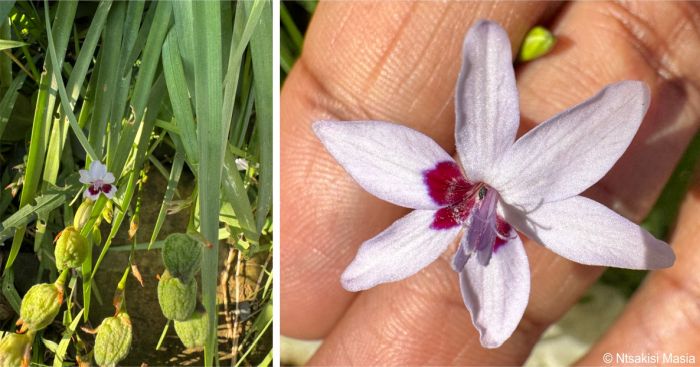
Uses
Use
There are no known medicinal or cultural uses for Freesia laxa subsp. azurea. It is also not very well known in horticulture, but would make an attractive addition to frost-free, coastal gardens. The genus Freesia is known worldwide as a garden plant and as well as a cut flower. The abundant bright flowers make it popular for being used ornamentally in gardens. It also attracts insects, like flies, which then increase pollination activities.
Growing Freesia laxa subsp. azurea
Grow
Freesia laxa can be easily propagated asexually during winter by lifting the corms and separating the cormels that form at base of the mother plant, to get new individual plants. Seeds can be sown directly on the ground by planting the seeds 2 cm deep, the sand must be well drained and the position fully exposed to the sun or in part shade, and occasionally watering it, germination is quick and abundant. If growing in trays, leave the corm to fully develop before transplanting, to allow better handling as corms can be too small.
In its natural habitat Freesia laxa subsp. azurea can be easily grow from seed if it is happy with the soil, they thrive in well-drained, sandy, low fertility soils. Naturally this plant likes coarse sandy soil in coastal scrub and in forest edges. In your garden it can be grown on exposed sites like grassy dunes or in light shaded areas in beds under shrubs, to edge flower beds, and it can also be grown as a pot plant. In cultivation Freesia laxa freely hybridizes freely.
References
- Goldblatt, P. & Hutchings, A. 1993. Anomatheca laxa subsp. azurea (Iridaceae), a new subspecies from coastal southern Mozambique and Natal, South Africa. Missouri Botanical Garden Press3(2):145-147.
- Goldblatt, P. & Manning, J.C. 2020. Iridaceae of southern Africa. Strelitzia 42. South African National Biodiversity Institute, Pretoria.
- Hyde, M.A., Wursten, B.T., Ballings, P. & Coates Palgrave, M. 2025. Freesia laxa subsp. azurea. Flora of Mozambiques. Online. https://www.mozambiqueflora.com/speciesdata/species.php?species_id=182080.
- Manning, J. 2004. Iridaceae. PlantZAfrica. Online. https://pza.sanbi.org/iridaceae.
- Manning, J.C. & Goldblatt, P. 2010. Botany and horticulture of the genus Freesia (Iridaceae). Strelitzia 27. South African National Biodiversity Institute, Pretoria.
- Pacific Bulb Society. Freesia. https://www.pacificbulbsociety.org/pbswiki/index.php/freesia. Accessed 1 Sep 2025.
- Pooley, E. 1998. A field guide to wild flowers of Kwazulu-Natal and the eastern region. Natal Flora Publications Trust, Durban.
- Von Staden, L. & Patel, T. 2021. Freesia laxa (Thunb.) Goldblatt & J.C.Manning subsp. azurea (Goldblatt & Hutchings) Goldblatt. National Assessment: Red List of South African Plants vesion . https://redlist.sanbi.org/species.php?species=1543-13.
- Woodhall, S. 2024-09, Observation of Freesia laxa subsp. laxa. iNaturalist. Online. https://www.inaturalist.org/observations/244494914.
Credits
Sibahle Gumede
Millennium Seed Bank Partnership
September 2025
Acknowledgements: the author thanks colleagues Ntsakisi Masia for providing some of the images and Ndileka Jaxa for providing access to the journals.
Plant Attributes:
Plant Type: Bulb
SA Distribution: KwaZulu-Natal
Soil type: Sandy
Flowering season: Spring, Winter
PH: Acid, Neutral
Flower colour: Blue, Purple, Mauve/Lilac
Aspect: Full Sun, Morning Sun (Semi Shade), Afternoon Sun (Semi Shade)
Gardening skill: Easy
Special Features:
Horticultural zones
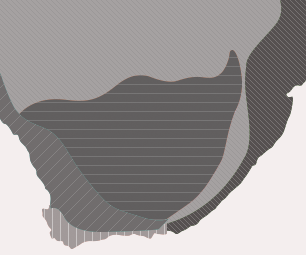






Rate this article
Article well written and informative
Rate this plant
Is this an interesting plant?
Login to add your Comment
Back to topNot registered yet? Click here to register.